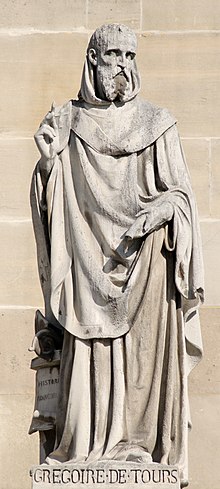Historia Francorum
| Saint Gregory of Tours | |
|---|---|

Saint Gregory of Tours, 19th century statue by Jean Marcellin, in the Louvre
|
|
| Bishop of Tours | |
| Born | 30 November c. 538 Auvergne, Gaul |
| Died | 17 November 593 or 594 Tours, Gaul |
| Venerated in | Roman Catholic Church, Eastern Orthodox Church |
| Feast | 17 November |
Saint Gregory of Tours (30 November c. 538 – 17 November 594) was a Gallo-Roman historian and Bishop of Tours, which made him a leading prelate of Gaul. He was born Georgius Florentius, later adding the name Gregorius in honour of his maternal great-grandfather. He is the main contemporary source for Merovingian history. His most notable work was his Decem Libri Historiarum or Ten Books of Histories, better known as the Historia Francorum ("History of the Franks"), a title given to it by later chroniclers, but he is also known for his accounts of the miracles of saints, especially four books of the miracles of Martin of Tours. St Martin's tomb was a major draw in the 6th century, and Gregory's writings had the practical aspect of promoting this highly organized devotion.
Gregory was born in Clermont, in the Auvergne region of central Gaul. He was born into the upper stratum of Gallo-Roman society as the son of Florentius, Senator of Clermont, by his wife Armentaria II, niece of Bishop Nicetius of Lyons and granddaughter of both Florentinus, Senator of Geneva, and Saint Gregory of Langres. Gregory had several noted bishops and saints as close relatives (his family effectively monopolised the Bishoprics of Tours, Lyons, and Langres at the time of his birth), and, according to Gregory, he was connected to thirteen of the eighteen bishops of Tours preceding him by ties of kinship. Gregory's paternal grandmother, Leocadia, descended from Vettius Epagatus, the illustrious martyr of Lyons.
His father evidently died while Gregory was young and his widowed mother moved to Burgundy where she had property. Gregory went to live with his paternal uncle St. Gallus, Bishop of Clermont), under whom, and his successor St. Avitus, Gregory had his education. Gregory also received the clerical tonsure from Gallus. Having contracted a serious illness, he made a visit of devotion to the tomb of St. Martin at Tours. Upon his recovery, he began to pursue a clerical career and was ordained deacon by Avitus. Upon the death of St. Euphronius, he was chosen as Bishop by the clergy and people, who had been charmed with his piety, learning, and humility. Their deputies overtook him at the court of King Sigebert of Austrasia, and being compelled to acquiesce, though much against his will, Gregory was consecrated by Giles, Bishop of Rheims, on 22 August 573, at the age of thirty-four.
...
Wikipedia
